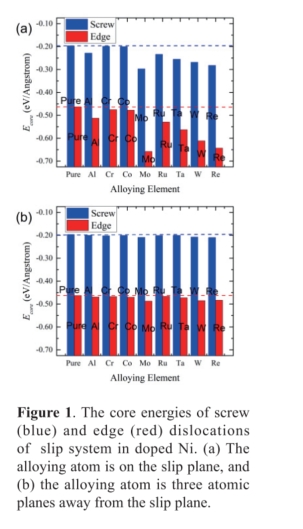ZHANG Limin', CAO Shuo\ ZHANG Xuechun, HU Qingmiao2, ZHANG Shangzhou
1 College of Nuclear Equipment and Nuclear Engineering, Yantai University, Yantai 264005, China;
2 Institute of Metal Research, Chinese Academy of Sciences, Shenyang 110016, China;
3 Institute for Advanced Studies in Precision Materials, Yantai University, Yantai 264005, China
EXTENDED ABSTRACT: The rafting of the microstructure of Ni-based superalloys deteriorates significantly the mechanical properties. According to the plastic rafting model based on the dislocation mechanism, the directional atomic diffusion induced by the interaction between the alloying atom and the interfacial dislocation is critical to the evolution of the rafting microstructure. However, to the best of our knowledge, the interaction between alloy atoms and dislocations in Ni-based superalloys is rarely reported in literature. In the present work, the interaction between the alloying atom and dislocation core in both matrix y phase and the precipitate y'phase are investigated by using a first principles method in combination with semi-discrete variational Peierls-Nabarro dislocation model. We show that the alloying atoms Al, Cr, Co, Mo, Ru, Ta, W, Re lower the dislocation core energy of the y phase, indicating that the alloying atoms are attractive to the dislocation core, as shown in Figure l. For the y'phase, W, Re, Mo, Ta, Cr raise whereas Co and Ru lower the dislocation core energy, i.e., Cr, Mo, Ta, W, Re are repulsive but Co and Ru are attractive to the dislocation core. With the calculated interaction between the alloying atoms and the dislocation core, the influence of these alloying elements on the microstructure rafting of the superalloy is discussed.
Keywords: Ni-based superalloys; first-principles; generalized stacking fault energy; dislocations; rafting

ZHANG Shangzhou has completed his PhD from the Institute of Metal Research, Chinese Academy of Sciences, is now a professor at the Institute for Advanced Studies in Precision Materials, Yantai University. He has long been engaged in research on the design and highthroughput characterization of high-performance structural materials, and has published more than 50 papers in domestic and international academic journals, and authorized more than 10 invention patents. He participated in the National Key R&D Program and presided over the major innovation projects in Shandong Province.